• Native trees should grow easily in Southern California, so why are so few of our street trees California natives?
• The highest priority is bringing more resilient shade trees to our urban areas, even if they come from someplace else.
• Bottom line: Native trees don’t fare well in the poor soil, limited space and polluting traffic along many of our city streets.
Welcome to October, where my to-do list will grow exponentially over the next three months with harvesting, decorating, baking, wrapping, sharing …. Yes, the impending holidays are all anticipation in October, and thus easy for me to love, until I am overwhelmed by the unceasing horror of “pumpkin spice.”
You’ll find plenty of fun plant-related activities listed below (P-22 celebrations! Oak-gall ink making! River cleanups!), but first, I have a question about street trees — the ones planted and maintained by public entities.
Fall is a great time to plant trees because the winter rains give them a chance to settle in before it gets too hot. Many municipalities and utilities offer free trees to residents to bring more shade and beauty to our urban areas, support wildlife and even reduce energy costs.
This towering sycamore tree lives outside a home in Ventura, with broad branches that grow horizontal as well as vertical.
(Jeanette Marantos / Los Angeles Times)
But if we want to increase our urban forests in Southern California, why don’t cities and counties plant more of our majestic native trees, like coast live oaks and sycamores? Don’t native trees grow more easily and happily than the predominately nonnative trees that line our streets?
Not really, according to arborists and even native plant proponents. As our average temperatures steadily increase, planting more shade trees is a priority for SoCal cities, “but there are differing opinions about what tree species are best, and being a native tree isn’t the highest ranking criteria,” said Michael King, coordinator of Pasadena’s forestry program. “In our industry we call it, ‘Right tree, right place’ — is the tree appropriate for where we want to put it?”
Bottom line: Many of our native trees don’t grow well in the urban conditions we’ve created, surrounded by traffic, concrete and asphalt with limited water and a growing medium that is more rubble than soil.

This bird’s-eye view of Griffith Park, with downtown L.A. visible in the distance, highlights the native chaparral shrubs common to Southern California.
(Al Seib / Los Angeles Times)
Furthermore, Southern California doesn’t have a deep bench when it comes to native trees, said Tim Becker, horticulture director for the Theodore Payne Foundation, one of the region’s premiere native plant and seed nurseries.
SoCal’s native flora is mostly chaparral, he said, woody shrubs like ceanothus, buckwheats, toyons, manzanitas, sumacs, sagebrush and sages. These shrubs can grow tall, but they’re usually shaggy and multi-trunked.
We do have some native trees, but several, like the stately Western sycamore, are riparian — dwelling next to rivers, not the heat islands of our city streets, said Becker.

The 300-year-old Majestic Oak at the California Botanic Garden in Claremont is believed to be the botanic garden’s oldest, with massive muscular limbs reaching around the perimeter of the tree.
(Dania Maxwell / Los Angeles Times)
There are, of course, our mighty oaks, which need almost no irrigation once they’re established. “They’re the grandest, most beautiful trees of Southern California,” Becker said. “They support the most wildlife, they’re the most long lived and they provide the most shade.”
But as a street tree, he said, oaks are just too big for most of L.A.’s narrow parkways — that strip of land between sidewalks and curbs where municipalities do most of their planting.
“It’s like, elephants are native to Africa, but would they survive that well in downtown Johannesburg if left to their own devices?” said Matthew Wells, public landscape manager for the city of Santa Monica.
Most municipalities require a parkway at least 10 feet wide for oaks and sycamores because they grow so large. Santa Monica is planting oaks along the wide median on Olympic Boulevard, West said, “but on Lincoln Boulevard we have high levels of pollution and very small growing spaces, so there’s not a lot of soil for trees to grow in.”
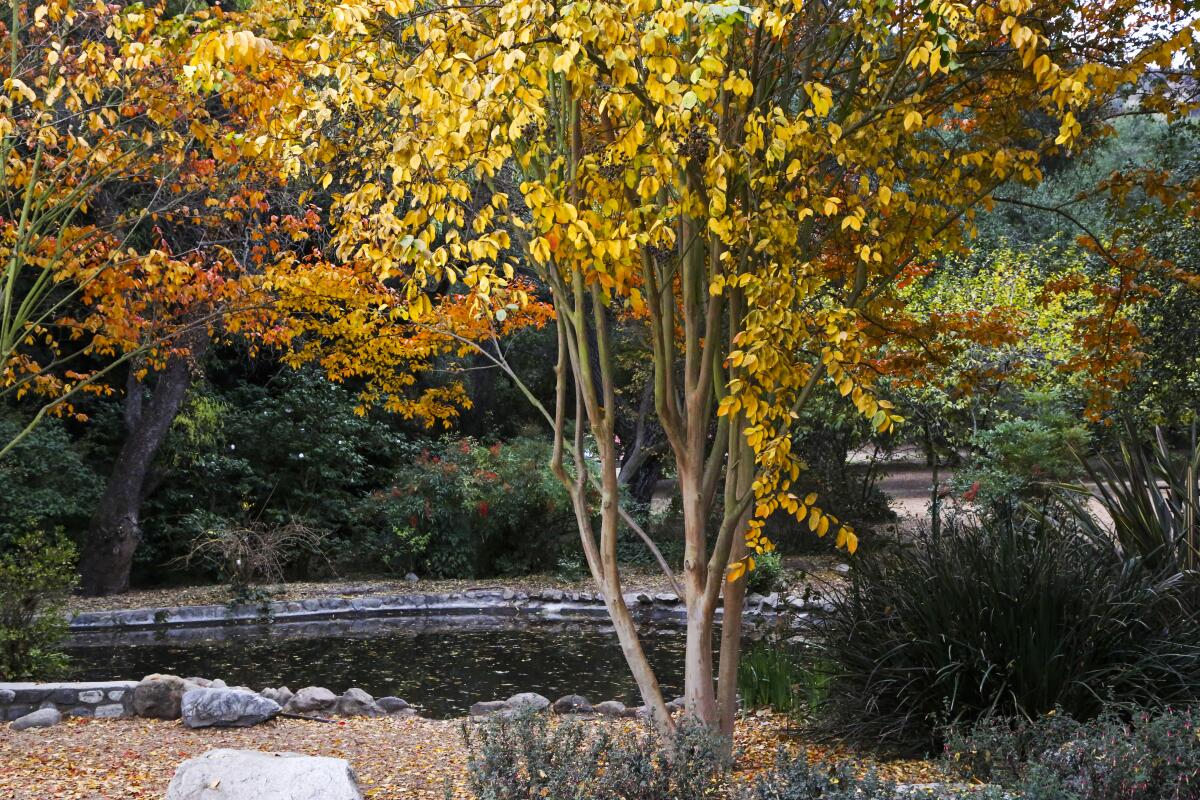
Crape myrtles, such as this compact tree at Descanso Gardens, are native to Asia. They have graceful branches, beautiful spring blooms and lovely fall colors before they drop their leaves in the winter, but they don’t provide much shade.
(Descanso Gardens)
TreePeople, the nonprofit organization that has been planting trees around the region for decades, always uses native plants for its habitat restoration projects, but street trees are different, said Marcos Trinidad, senior director of programs. His organization must work in partnership with municipalities and thus find trees that work for that community, even if those trees aren’t native.
Urban foresters have to consider overhead wires, access to parking, roots that might damage sidewalks and streets, underground water lines, even the visibility of business signs. “We’ve planted trees thinking people would embrace the beauty and shade, only to find out the business owners or landlords have pruned the trees in such a way that allows the community to see their advertisements at all times,” Trinidad said. Good for business maybe, but not for the trees.
Nonnative trees create problems too. Huge ficus roots upend sidewalks and streets. People love blooming trees, but jacaranda flowers leave a terrible mess. Compact crape myrtles grow easily with lovely flowers but don’t provide much shade, said Trinidad, and they’re so omnipresent many foresters have stopped planting them. “We don’t want to oversaturate a neighborhood with just one species,” he said, “because then if a pest or disease comes through, we’ll lose a large part of our canopy.”

Mature ficus trees bring tremendous shade and beauty to our city streets, but their large roots can be devastating to sidewalks.
(Lila Seidman / Los Angeles Times)
Another goal is finding trees that require little or no maintenance once they’re established. Los Angeles County budgets about $20 million for street trees, but almost all of that money is spent on maintenance like pruning, not planting new trees, said Steve Burger, the county’s deputy director of transportation.
Native Torrey pines (Pinus torreyana) and desert willow (Chilopsis linearis) are becoming popular for their resilient beauty and relatively compact growth. Endangered Southern California black walnut provide good shade but can be messy, dropping flowers and leaves. Native Western redbuds (Cercis occidentalis) have spectacular spring blooms, but foresters prefer the very similar Eastern redbud (Cercis canadensis), because it grows more often with a single trunk.
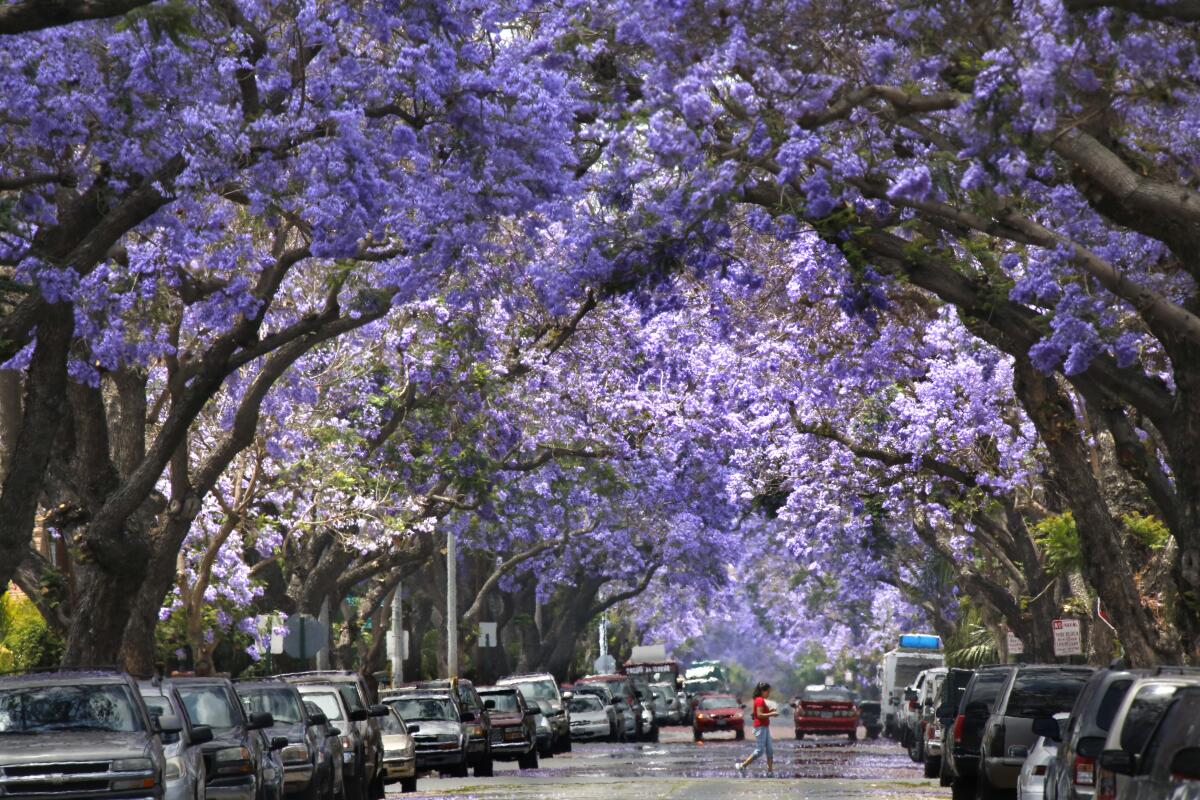
The 182 jacaranda trees along Myrtle Street in old Santa Ana create a purple haze spectacle — and gooey mess when the flowers drop — every spring.
(Don Bartletti / Los Angeles Times)
Foresters are planting oaks whenever they can find the space, Trinidad said, such as on 14-foot parkways near UC Riverside, but heat tolerant nonnative shade trees still dominate, such as Australian willow, African sumac, pink trumpet tree, gold medallion, magnolias, tristania (a.k.a. Brisbane box tree) and, yes, the jacaranda. Messy or not, they grow with great resilience, provide abundant shade and bloom with breathtaking beauty … just park somewhere else.
Newsletter
You’re reading the L.A. Times Plants newsletter
Jeanette Marantos gives you a roundup of upcoming plant-related activities and events in Southern California, along with our latest plant stories.
You may occasionally receive promotional content from the Los Angeles Times.
Upcoming events
Oct. 5-Nov. 10
UC Master Gardeners’ Grow L.A. Garden Classes, four sessions taught by master gardeners on various dates at community gardens in Altadena, Hollywood, Long Beach (bilingual instruction) and Pomona (other locations are already full). The classes cover gardening basics such as soil preparation, irrigation, planting, pest management and harvesting. Registration is required; the fee is $70 or $30, depending on ability to pay. celosangeles.ucanr.edu
Oct. 5
FoLAR’s (Friends of the L.A. River’s) 34th Great L.A. River Cleanup at Bull Creek in Van Nuys, North Atwater Park in Atwater Village, Compton Creek in Compton and Willow Street Bridge in Long Beach. Cleanups begin at 8 a.m. or 10:30 a.m., depending on the site. Rain cancels for safety reasons. Registration required. All ages are welcome; gloves and trash bags provided. folar.org
South Coast Chapter of the California Native Plant Society Native Plant Sale, 10 a.m. to 2 p.m. at the Madrona Marsh Nature Center. The sale will include lots of narrowleaf milkweed plants (Asclepias fascicularis). chapters.cnps.org/southcoast
L.A. County Arboretum Gift Shop Reopening noon to 4:30 p.m. (members only 8 a.m. to noon) at the Arboretum in Arcadia. The gift shop has been closed for many years, and the new, larger space features gifts for gardeners and many climate-appropriate plants, including California native plants and seeds from the Theodore Payne Foundation. After Oct. 5, the shop will be open daily from 9 a.m. to 4:30 p.m.; admission to the Arboretum is not required. arboretum.org
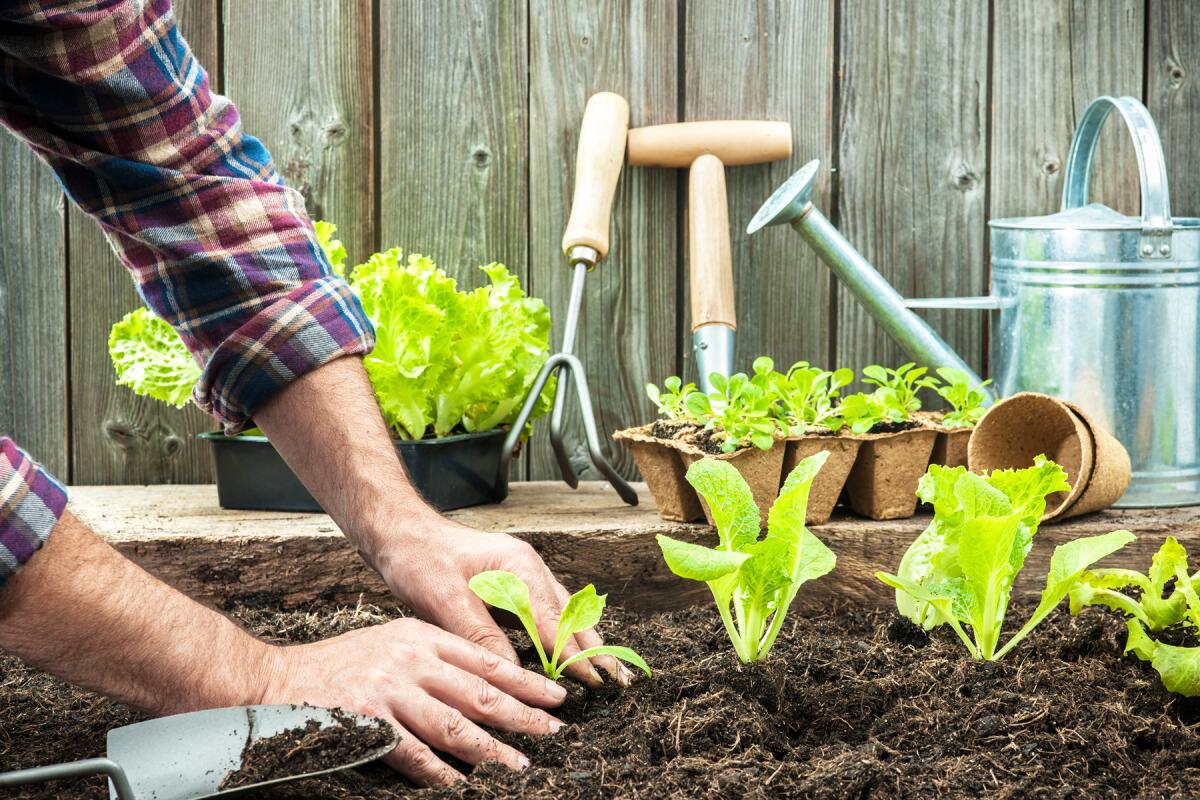
A farmer plants young seedlings of lettuce salad in a vegetable garden
(Alexander Raths / stock.adobe.com)
Veggie Gardening and California Native Plants, a class about growing veggies, fruit trees and native plants side by side taught by Sophie Pennes, founder of Urban Farms LA from 10 a.m. to noon at the Theodore Payne Foundation. The class includes lessons in growing food in raised beds, irrigation and companion planting with natives. Register online, $39.19 ($28.52 members). eventbrite.com
North East Trees’ Hollyleaf Cherry Transplanting and Seed Processing, a chance to help the nonprofit group grow more native hollyleaf cherry trees for distribution during its monthly volunteer event, 9 a.m. to noon at Ascot Hills Park Nursery in El Sereno. Snacks and water will be available. Participation is free, but participants must register online and sign a waiver. northeasttrees.org
Chino Basin Water Conservation District’s Waterwise Garden & Pumpkin Fest, 10 a.m. to 2 p.m. at the district’s offices in Montclair, includes free compost, resources for water conservation, a plant sale and a pumpkin patch along with pumpkin decorating and succulent pumpkin-making (attaching living succulents to pumpkins). Admission is free. cbwcd.org
Oct. 7
Native Plants and the Future of the L.A. River, a talk by landscape ecologist Isaac Brown of Stillwater Sciences, a consulting firm specializing in river restoration, 7 p.m. at the Madrona Marsh Preserve & Nature Center in Torrance during the October meeting of the South Coast Chapter of the California Native Plant Society. Admission is free. chapters.cnps.org/southcoast/
Oct. 9
Garden Pumpkin for Autumn, a class about decorating pumpkins with dried leaves and flowers using decoupage, 10 a.m. to noon at Sherman Library & Gardens in Corona del Mar. All materials are provided; register online, $50 ($45 for members). thesherman.org
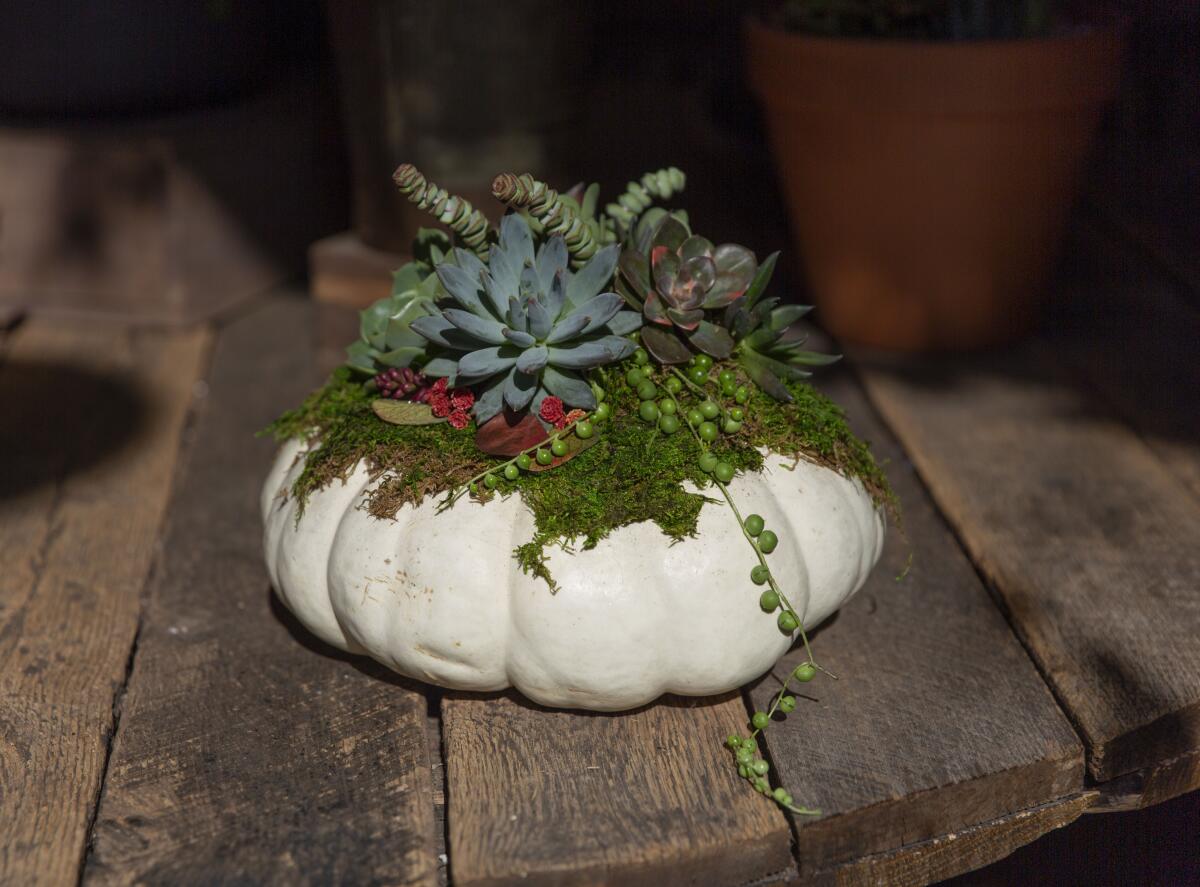
A succulent pumpkin created by Brianne Bird of Rolling Greens Beverly nursery.
(Allison Zaucha / For The Times)
Oct. 10
Pumpkin Patch Elegance: A Succulent Pumpkin Workshop, 10 to 11:30 a.m. at Sherman Library & Gardens in Corona del Mar. All materials provided to create a succulent arrangement on top of a pumpkin. Register online, $135 ($125 for members). thesherman.org
Oct. 12-13
California Botanic Garden Grow Native Nursery reopening, 10 a.m. to 4 p.m. (members can shop from 8 to 10 a.m. on Oct. 12) at the nursery in Claremont. Members get 10% off their purchases. The nursery will be open Fridays-Sundays, 10 a.m. to 4 p.m., into the spring. Admission to the garden is not required. calbg.org
Oct. 13
South Bay Water-Wise Garden Tour, 10 a.m. to 4 p.m, a self-guided driving tour of gardens using native and other drought tolerant plants in El Segundo, Gardena, Hawthorne, Hermosa Beach, Lomita, Manhattan Beach, Palos Verdes, Redondo Beach and Torrance. All proceeds will be donated to the Gardena Willows Wetland Preserve. Tickets are $10 (children 10 and under are free) and can be bought online before Oct. 9 or the day of the event at 16116 Ardath Ave. in Gardena, cash only. southbaywaterwisegardentour.com
Wallis Annenberg Wildlife Crossing Open House, 1 to 3 p.m. at the King Gillette Ranch Visitor Center in Calabasas, will introduce the team building the wildlife crossing over the 101 Freeway in Agoura Hills and provide updates on the project scheduled for completion at the end of 2025. Food and beverages will be available; admission is free. savelacougars.org

The Wallis Annenberg Wildlife Crossing under construction in Agoura Hills over the 101 Freeway in April, before the girders were put in place this summer.
(Brian van der Brug / Los Angeles Times)
Oct. 17
Fire-Resistant Gardens: A Maintenance Walk and Talk, with Theodore Payne Foundation educator Erik Blank, 10 a.m. to noon at the foundation’s demonstration garden in Sun Valley. The class discusses how garden design and maintenance like pruning can create a fire-resilient landscape. The class will be held indoors and then involve at least an hour of walking on uneven surfaces. Register online, $17.85 ($12.51 for members). eventbrite.com
Oct. 18-19
California Botanic Garden’s Things That Go Bump in the Night family festival lets adults and children explore the nocturnal worlds of plants and animals scattered throughout the state’s largest botanic garden dedicated to California native plants, from 5:30 to 9 p.m. in Claremont. Visitors are encouraged to bring flashlights. Tickets are $20 ($15 for seniors, students with ID, children ages 3-12 and adult members; $10 for members who are seniors, students with ID or children 3-12). calbg.org
Oct. 19
National Wildlife Federation’s Ninth P-22 Day Festival, 11 a.m. to 3:30 p.m. in Griffith Park, in honor of the legendary cougar P-22 who crossed two busy freeways to settle in Griffith Park until his death in December 2022. The event includes exhibits and activities about local wildlife and their habitat. Admission is free. savelacougars.org
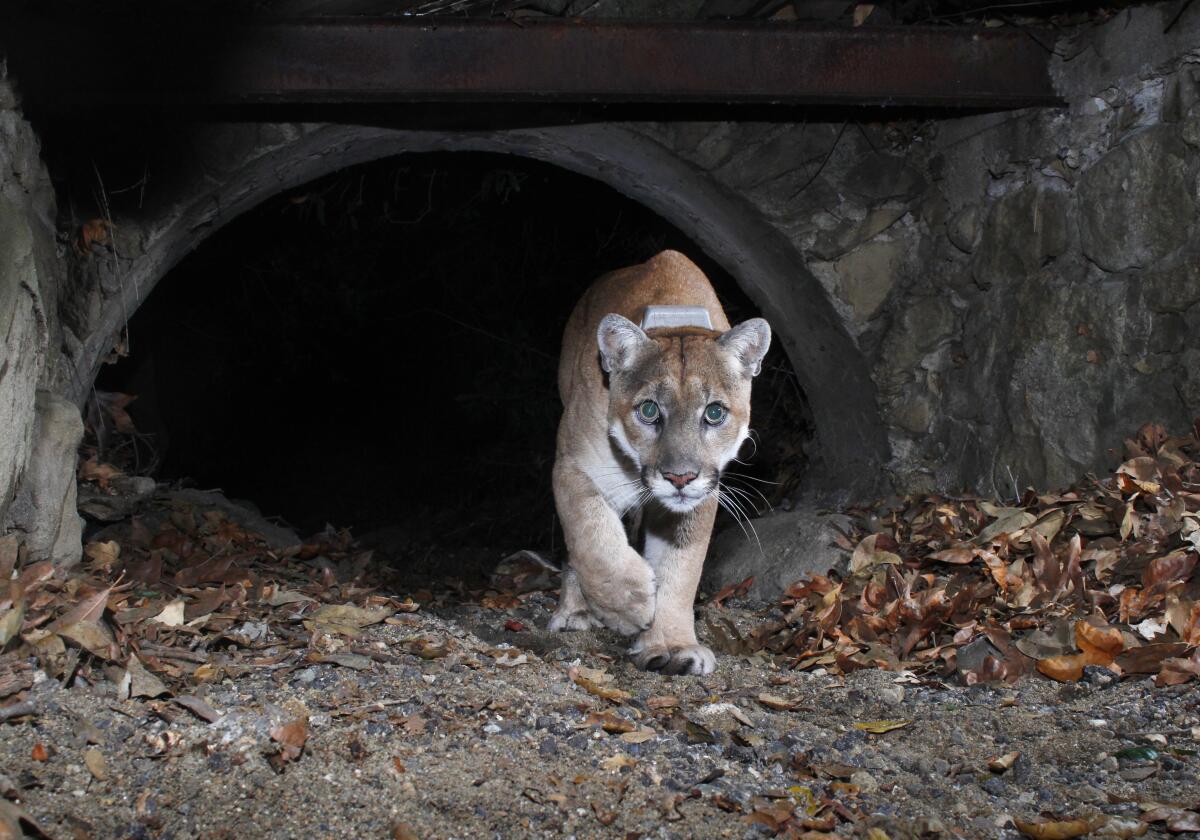
A photo of the famous cougar P-22 taken at 1:09 a.m. on Dec.19, 2016, in Griffith Park.
(Miguel Ordeñana)
Southern California Horticultural Society’s 2024 Horticulturist of the Year Banquet honoring Santa Monica landscape designer Nancy Goslee Power, 5 to 9 p.m. at the Sparr Heights Community Center in Glendale. Tickets are $65, and available until Oct. 11. socalhort.org
Oak Gall Inks, a hands-on workshop taught by L.A. artist Kim Russo in making inks from the growths created on oak branches when gall wasps lay their eggs, 2:30 to 4:30 p.m. at the Theodore Payne Foundation outdoor classroom in Sun Valley. Participants should wear clothes that can get messy and bring a mallet, small hammer or rolling pin to smash the oak galls and an empty glass jar (at least 8 ounces) with a tight-fitting lid to hold their ink. Register online, $65.87 ($55.20 for members). eventbrite.com
Oct. 22
Spooky Scuttlers and Creepy Crawlies, an introduction to the insects commonly found around California native plant gardens, 10 to 11:30 a.m. at the Theodore Payne Foundation demonstration center in Sun Valley. Community Engagement Manager Lou Avery Douglas will lead participants on uneven terrain, so closed-toe shoes are recommended. Register online, $35 ($28.52 for members, $17.85 for ages 13-18). eventbrite.com
Oct. 25
Nature Journaling: Looking at Leaves, 9 to 11 a.m. at the Theodore Payne Foundation demonstration garden in Sun Valley. This class will help participants learn about plants by closely observing and sketching their leaves. Participants are encouraged to bring their own journal or sketchbook and drawing materials; loose paper and pencils will be provided. Register online, $33.85 ($28.52 for members). eventbrite.com

A glowing cholla cactus outside the Mojave Desert Land Trust office in Joshua Tree.
(Gina Ferazzi / Los Angeles Times)
Oct. 26
Mojave Desert Land Trust’s annual native plant sale, 10 a.m. to 2 p.m. at the land trust’s headquarters in Joshua Tree. The sale includes more than 75 species of California native plants that grow in the desert, including a few new varieties this year — scarlet milkvetch (Astragalus coccineus), yellow bush penstemon (Keckiella antirrhinoides), fragrant sumac (Rhus aromatica) and desert purple sage (Salvia dorrii). Sign up for the newsletter to get more information. Admission is free. mdlt.org
Oct. 26-27
Chrysanthemum Flower Show at Sherman Library & Gardens, 10:30 a.m. to 4 p.m. each day at the gardens in Corona del Mar. The show includes a crysanthemum-focused class at 11:30 a.m. each day. The show is free with $5 entry to the gardens (members and children 3 and younger enter free). thesherman.org
Oct. 29-Nov. 9
Fall Plant Sale at the Theodore Payne Foundation, 8:30 a.m. to 4:30 p.m at the foundation’s nursery in Sun Valley. Shoppers receive a 10% discount at the sale (15% discount for members), but reservations are required to park next to the nursery, due to limited space, at 8:30 a.m., 10 a.m., 12 p.m. or 2 p.m. Street parking is also available, a few blocks from the nursery. Admission is free, reserve parking spaces online. eventbrite.com
Consider subscribing to the Los Angeles Times
Your support helps us deliver the news that matters most. Become a subscriber.
What we’re reading
Speaking of trees …. Whittier is wrestling with a controversial redevelopment plan that would remove 80 mature ficus trees from its downtown core, and this story by my colleague Lila Seidman really captures the struggles that foresters face with choosing trees for our communities, and the outrage that can follow when they get it wrong.
The spiders have been out in force this year, which means many of us will be flailing brooms as we walk through our gardens this fall to avoid entanglement with giant orb weaver webs. Climate reporter Seidman offers a fascinating look at why we’re seeing more spiders this year.
Aurora Anaya wanted a garden with year-round color when she swapped her old lawn in Whittier for a native plant landscape. A bonus was a yard full of fragrance and endangered monarch butterflies.
Laura La Rue grows plants to make dyes for her tie-dye creations. She’s also a single mom living in a converted school bus with her toddler daughter, a dog and a cat in what seems like an idyllic life spent mostly outdoors in Ojai.





